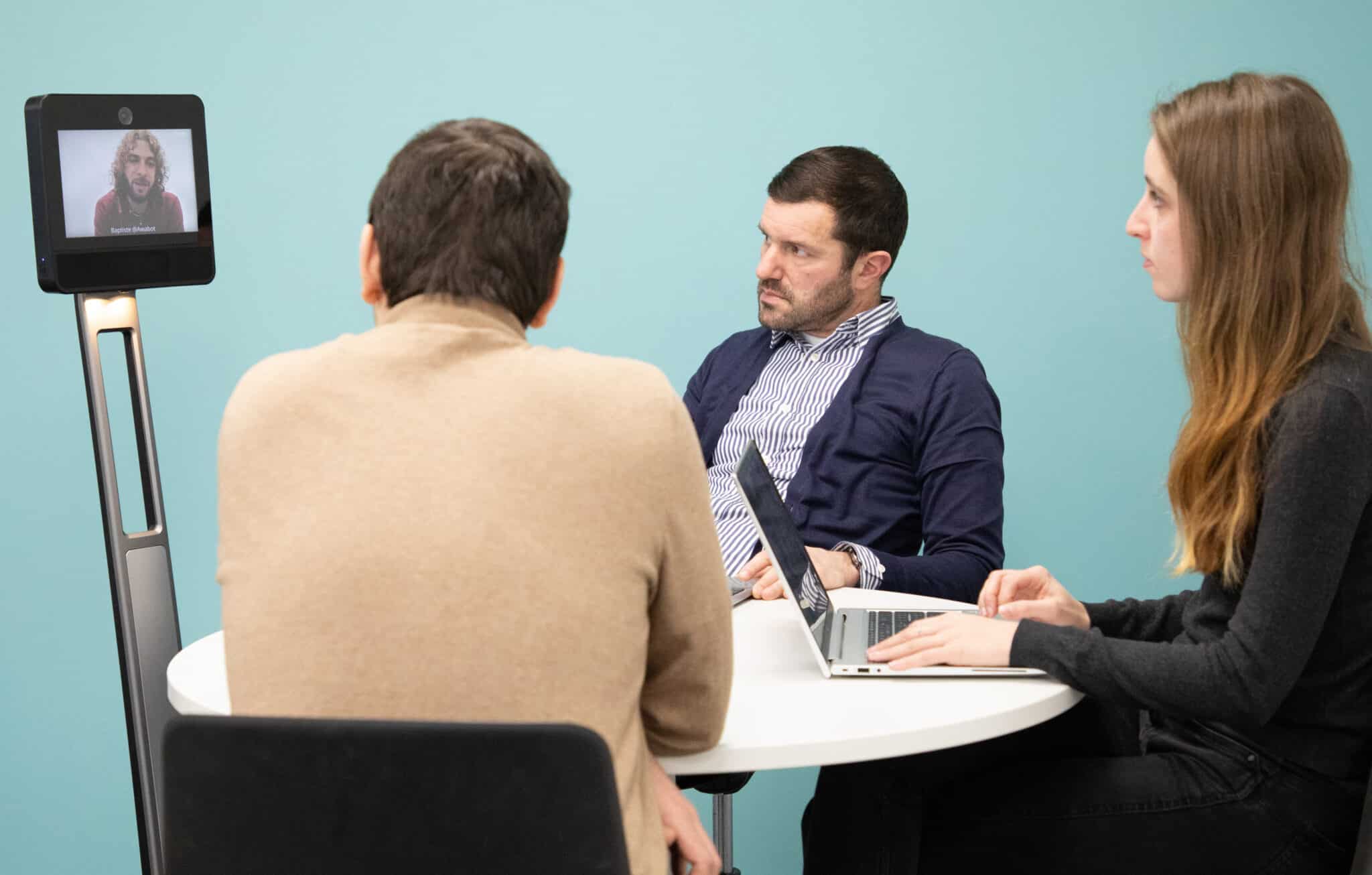If you want to improve the quality of your interactions when using a telepresence robot, follow these recommendations, on the driver’s side and on the other participants’ side, and your telepresence experience will go to the next level!
First of all, before using a telepresence robot, make sure you have checked the connectivity requirements of the places where the driver makes his connection and where the robot is placed. Indeed, these connections must be sufficiently powerful. A wired connection (Ethernet cable) is recommended, but it is also possible to use a Wi-Fi connection (ADSL, VDSL2, optical fiber or 4G). In order to maximize the connection speed, downloads, PC games, or video streaming are not recommended, during the whole driving time.
On the robot side, encourage interaction…
1. An optimized environment for movements
The telepresence robot is designed to move alongside humans. To do so, its movement area must be relatively flat and as free of obstacles as possible. Especially outdoors, certain terrains littered with holes are often not conducive to the robot’s navigation. Therefore, choose rather flat ground.

2. A warm welcome for the caller in Beam®
Although interacting with a person via a telepresence robot may seem confusing at first, immersion depends largely on how the robot is integrated with the interlocutors. The appearance of Beam® is deliberately sober so that people talking to the robot forget about it and quickly see only the connected person. Once the astonishment is over, there is no difference between the people on site and those in Beam®.
3. A special robot signage
Setting up a traffic code on the floor is often a successful way to allow the person connected via Beam® to be more autonomous. Indeed, you can place colored tape on the floor to mark a passage where no object should be present to allow the robot to move. This is particularly useful when the robot is used in an industrial or busy environment. It also warns people on site that a robot is likely to pass by and that they should pay attention to it. A Beam® version of the highway code!
4. The location of the base: a strategic choice
It may not seem like a big deal at first, but where you place the Beam® charging base is not without consequence. If it is in a hidden place, the robot will potentially be forgotten and unused. Of course, it should not be in the way of people passing by, but putting it in a corner is not a good solution. Beam® must become a tool, almost a full-fledged member of the space. Moreover, placing it in a place close to the passage is a good way to arouse the interest of visitors who will be amazed by the presence of a robotic technology in this place.

5. Taking care of Beam®.
Preserve your telepresence robot, especially its battery, to ensure a long and beautiful life (and also avoid returns to the after-sales service). To do so, there are three important things to know:
- if Beam® is no longer in use for the day, make sure it is charged on its charging base, plugged in ;
- if you are not going to use it for a long time and you want to leave it out of its base, turn off your robot by following the good practices. As a reminder, the button on the side of the head of the device is a sleep button, not an off button;
- make sure the device is charged once a day when not in use. To do this, check to see if the LED is on when it is parked on its charging base.
… & on the driver side, a good configuration
Last April, we already shared with you 5 tips to optimize your pilot setup and thus live the best possible telepresence experience.
In short, here are our recommendations for a successful pilot immersion in telepresence:
6. Set up in an environment conducive to immersion
Set up on a neat desk with your computer and its peripherals (mouse, keyboard). In order to optimize the image quality :
- choose a clear and plain background behind you;
- make sure you are not in backlight, or adjust the brightness of your webcam

7. Look your best
Face à votre caméra, installez-vous de manière à montrer votre visage et votre ligne d’épaule. Et n’oubliez pas qu’il est important d’orienter votre regard sur la caméra afin de regarder votre interlocuteur dans les yeux et être convainquant.
8. Procéder aux réglages du micro
It is essential to check with your interlocutors the sound level of your voice as soon as you start your connection. A microphone icon, located in your functionalities bar, allows you to adjust the sound level of your voice according to the volume on the robot side. For a better voice reproduction, using a hands-free kit is strongly recommended.

9. Adjust the volume of your callers
Just as you can change the volume of your microphone, you also have a feature that lets you adjust the sounds you hear through the robot.
If you are using a BeamPro® in a space where the volume is high, you have the option to attenuate the ambient noise with the “party mode” or “anti-noise mode” option in the “Audio” settings.
10. Provide information about yourself

Under your camera return, you have a free field allowing you to indicate information that will be displayed on the Beam® screen. Communicate to your interlocutors your name, your location, the company you work for, etc.
Bonus: become a skilled Beam® pilot
The key to successful robot navigation is to control the robot as smoothly as possible. For this, it is advisable to alternate mouse (or trackpad) and directional arrows. In addition, when you move your mouse over the navigation camera, blue directional lines appear to indicate the robot’s trajectory and thus gauge your passage between two obstacles.

What are your tips for a successful telepresence robot immersion? Share your tips on Twitter or LinkedIn by mentioning @Awabot.
Want to know more about the telepresence devices offered by Awabot? Contact our team now.




